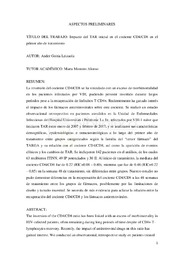Por favor, use este identificador para citar o enlazar este ítem:
https://hdl.handle.net/11000/27314Registro completo de metadatos
| Campo DC | Valor | Lengua/Idioma |
|---|---|---|
| dc.contributor.advisor | Montero Alonso, Marta | - |
| dc.contributor.author | Goitia Leizaola, Ander | - |
| dc.contributor.other | Departamentos de la UMH::Medicina Clínica | es_ES |
| dc.date.accessioned | 2022-05-24T13:41:56Z | - |
| dc.date.available | 2022-05-24T13:41:56Z | - |
| dc.date.created | 2017-09-19 | - |
| dc.identifier.uri | http://hdl.handle.net/11000/27314 | - |
| dc.description.abstract | La inversión del cociente CD4/CD8 se ha vinculado con un exceso de morbimortalidad en los pacientes infectados por VIH, pudiendo persistir invertido durante largos periodos pese a la recuperación de linfocitos T CD4+. Recientemente ha ganado interés el impacto de los fármacos antirretrovirales sobre este cociente. Se realizó un estudio observacional retrospectivo en pacientes atendidos en la Unidad de Enfermedades Infecciosas del Hospital Universitari i Politècnic La Fe, infectados por VIH-1 naïve que iniciaron TAR entre enero de 2007 y febrero de 2017, y se analizaron sus características demográficas, epidemiológicas e inmunovirológicas a lo largo del primer año de tratamiento entre grupos categorizados según la familia del ¿tercer fármaco¿ del TARGA y su relación con el cociente CD4/CD8, así como la aparición de eventos clínicos y los cambios de T AR. Se incluyeron 142 pacientes en el análisis, de los cuales 63 recibieron ITINN, 49 IP potenciados y 30 II. Al inicio de tratamiento, la mediana del cociente CD4/CD8 fue de 0.22 (RIC=0.08 ¿ 0.40), mientras que fue de 0.48 (RIC=0.22 ¿ 0.85) en la semana 48 de tratamiento, sin diferencias entre grupos. Nuestro estudio no pudo demostrar diferencias en la recuperación del cociente CD4/CD8 a las 48 semanas de tratamiento entre los grupos de fármacos, posiblemente por las limitaciones de diseño y tamaño muestral. Se necesita de más evidencia para aclarar la relación entre la recuperación del cociente CD4/CD8 y los fármacos antirretrovirales. | es_ES |
| dc.description.abstract | The inversion of the CD4/CD8 ratio has been linked with an excess of morbimortality in HIV-infected patients, often remaining during long periods of time despite of CD4+ Tlymphocytes recovery. Recently, the impact of antiretroviral drugs on this ratio has gained interest. We conducted an observational, retrospective study on patients treated 2 in the Infectious Disease Unit in Hospital Universitari I Politècnic La Fe, which were infected with HIV-1, treatment-naïve, and which started ART between January 2007 and February 2017. Their demographic, epidemiologic and immunovirologic features during first year of treatment were analyzed, according to the family of the “third drug” of HAART and its association with CD4/CD8 ratio, and so were the incidence of clinical events and treatment modifications. 142 patients were included in the analysis, of which 63 received NNRTIs, 49 boosted-PIs and 30 INSTIs. Before treatment start, median CD4/CD8 ratio in our population was 0.22 (IQR=0.08 – 0.40), while it was 0.48 (IQR=0.22 – 0.85) at week 48 of treatment, without statistically significant differences between groups. Our study failed to demonstrate differences in CD4/CD8 recovery at 48 weeks of treatment between drug groups, possibly because of limitations of design and sample size. More evidence is needed to clarify the association between ARV drugs and CD4/CD8 ratio recovery. | es_ES |
| dc.format | application/pdf | es_ES |
| dc.format.extent | 26 | es_ES |
| dc.language.iso | spa | es_ES |
| dc.publisher | Universidad Miguel Hernández de Elche | es_ES |
| dc.rights | info:eu-repo/semantics/openAccess | es_ES |
| dc.rights.uri | http://creativecommons.org/licenses/by-nc-nd/4.0/ | * |
| dc.subject | VIH | es_ES |
| dc.subject | CD4/CD8 | es_ES |
| dc.subject | Fármacos antirretrovirales | es_ES |
| dc.subject.other | CDU::6 - Ciencias aplicadas::61 - Medicina::616 - Patología. Medicina clínica. Oncología | es_ES |
| dc.title | Impacto del TAR inicial en el cociente CD4/CD8 en el primer año de tratamiento | es_ES |
| dc.type | info:eu-repo/semantics/masterThesis | es_ES |

Ver/Abrir:
GOITIA LEIZAOLA, ANDER.pdf
144,96 kB
Adobe PDF
Compartir:
 La licencia se describe como: Atribución-NonComercial-NoDerivada 4.0 Internacional.
La licencia se describe como: Atribución-NonComercial-NoDerivada 4.0 Internacional.
.png)